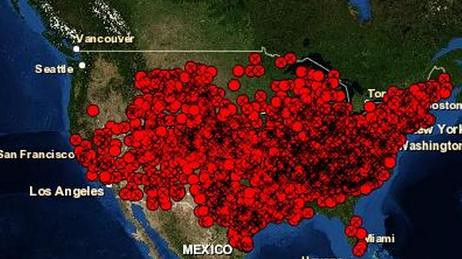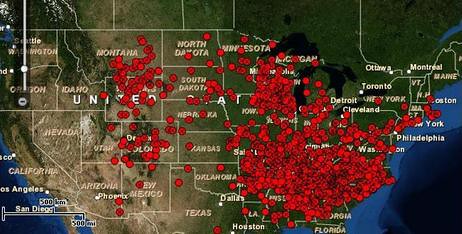Its been really, really HOT so far this summer after a very warm winter (by North American standards). But how hot has it been? Well, a government agency, that I’m certain a host of radical far right Republican Congressional members (which in the current time may amount to nearly all of them) would like to see eradicated so we can have more tax cuts, provides us the answer in a very graphic form (though not so graphic that it’s NSFW). Look at this first image from June of this year:

That map represents 2,284 maximum temperature records that were broken and another 998 were tied in the United States from June 1st through June 30th (maximum being the highest recorded temperature for that day for each location). But wait, there’s more. Here are the figures for just the first 5 days of July presented in graphical form:

For July — i.e., July 1st through July 5th — there has been 942 records broken and 273 that were tied. For 2012 to date, 23,613 maximum temperature records have been set. Over the same period in 2011, only 13,582 maximum temperature records were broken. That is an increase of 71% over last year, which was more than hot enough as I recall. What’s even more worrying is that, while all these temperature maximums are being set, the earth at 94.5 million miles away from the sun, the farthest distance it will be this year, and we are breaking record high temperatures willy-nilly, like a store holding a going out of business sale.
Now the popular opprobrium dished out by those who deny that global warming is rapidly and perhaps irreversibly changing our climate, or that such claims of climate change are overblown or that even if change is occurring human activities have nothing to do with it, is to call people like myself, who post about data such as this, which demonstrates how quickly and radically our climate has already changed — well they call us “alarmists.”
Well I am alarmed. Very alarmed.
(cont.)
I’m alarmed by the severity and increase in droughts around the world.
I’m alarmed by the increase in severe storms and extreme weather such as the recent derecho that swept through the Midwest and Mid-Atlantic states last week.
I’m worried about the extent and volume of sea ice that has vanished in just the last decade, making it now viable to drill for oil and gas in the Arctic Ocean.
[Secretary of the Interior Ken] Salazar commented as he announced more Alaska offshore real estate will be included in the 2012-2017 five-year oil and gas lease program — the Chukchi Sea in 2016 and the Beaufort in 2017. The Shell experience, he said, will develop critical science and information to guide future development.
Shell hopes to drill in both seas during the 2012 open water season. The Kulluk, a 266-foot ship with a hull reinforced for ice, and the Noble Discoverer left Seattle on Wednesday for Dutch Harbor in the Aleutians, where they will wait for open water this month for the last leg to the Beaufort and the Chukchi.
Shell estimates it has spent more than $4 billion on Arctic offshore development. The target is the 26.6 billion barrels of recoverable oil and 130 trillion cubic feet of natural gas estimated by federal managers.
I’m alarmed by the rapid increase in the extinction of species, including many plants that we raise and consume such as coffee.
On Friday, the director of sustainability for Starbucks, Jim Hanna, said climate change is threatening the world’s coffee supply, telling the Guardian newspaper, “What we are really seeing as a company as we look 10, 20, 30 years down the road — if conditions continue as they are — is a potentially significant risk to our supply chain, which is the Arabica coffee bean.”
“Coffee likes a pretty narrow range of temperatures, and one of the hallmarks, really, of climate change will be increased extremes in temperatures,” Todd Sanford, a climate scientist from the Union of Concerned Scientists, said.
Scientists say climate change will cause heavier rains, longer periods of drought, and higher rates of insect infestation in the tropical areas where coffee is grown — factors that could have a devastating effect on future coffee production.
“Those of us who enjoy our morning cup of coffee, we may not always realize that future climate change due to extreme temperatures, increased precipitation, really could in some ways put that at risk,” Sanford added.
I’m alarmed by the increasing acidification of our oceans because of their absorption of carbon dioxide.
When we spew carbon dioxide into our air, it eventually ends up in our oceans, too — absorbed to the tune of about 22 million tons per day. This results in global warming’s evil twin: ocean acidification.
As oceans absorb carbon dioxide, or CO2, seawater chemistry changes and the water becomes more acidic. According to scientists, the oceans have become about 30 percent more acidic due to human CO2 emissions — and this spells trouble for ocean life. First of all, ocean acidification depletes seawater of the compounds that organisms need to build shells and skeletons, impairing the ability of corals, crabs, seastars, sea urchins, plankton and other marine creatures to build the protective armor they need to survive. To make matters worse, fish and other ocean organisms may be adversely affected from the rise in acidity in their ocean habitat. Fish are common ocean prey, and plankton are at the base of the ocean food chain, so when these animals suffer, so do the countless animals that eat them. Ocean acidification could disrupt the entire marine ecosystem.
I’m alarmed by the reports that the Gulf Stream and other ocean currents are being altered in ways predicted by many of the current climate models, causing increased sea rise along our eastern seaboard, among other effects.
U.S. Geological Survey (USGS) scientists call the 965-kilometre swath extending from Cape Hatteras, N.C., to Boston a “hot spot” for climbing sea levels caused by a combination of global warming and changes in the structure and speed of ocean currents in the region.
Along the region, the Atlantic Ocean is rising at an annual rate three to four times faster than the global average since 1990, according to the study published Sunday in the journal Nature Climate Change.
It’s not just a faster rate, but at a faster pace, like a car on a highway “jamming on the accelerator,” said the study’s lead author, Asbury Sallenger Jr., an oceanographer with USGS. He looked at sea levels starting in 1950 and noticed a change beginning in 1990.
What I want to know is why climate change deniers aren’t more alarmed by what our scientists say, and by the mounting evidence that our climate is changing far more rapidly than even the most “alarmist” climate scientists predicted only a few years ago. it seems to me the only rational response to the reports and data regarding climate and global warming is to be deeply alarmed. But then again, I recall how the tobacco industry fought against health warnings on cigarettes and sought to discredit scientists who suggested that smoking greatly increased the risk of cancer, lung and heart disease not so long ago. And — surprise, surprise — many of those same critics of the scientific evidence that smoking caused health risks, and that acid rain from sulfur emissions by power plants was not anything to be concerned about are now the same people who seek to discredit climate scientists.
Many books have recently documented the games played by the climate-change deniers. Merchants of Doubt, a new book by Naomi Oreskes and Erik Conway set for release in mid-2010, will be an authoritative account of their misbehaviour. The authors show that the same group of mischief-makers, given a platform by the free-market ideologues of The Wall Street Journal’s editorial page, has consistently tried to confuse the public and discredit the scientists whose insights are helping to save the world from unintended environmental harm.
Today’s campaigners against action on climate change are in many cases backed by the same lobbies, individuals, and organisations that sided with the tobacco industry to discredit the science linking smoking and lung cancer. Later, they fought the scientific evidence that sulphur oxides from coal-fired power plants were causing “acid rain.” Then, when it was discovered that certain chemicals called chlorofluorocarbons (CFCs) were causing the depletion of ozone in the atmosphere, the same groups launched a nasty campaign to discredit that science, too.
Later still, the group defended the tobacco giants against charges that second-hand smoke causes cancer and other diseases. And then, starting mainly in the 1980s, this same group took on the battle against climate change.
So the next time someone calls you an “climate change” or “global warming” alarmist, regarding the issue of man-made climate change, run down the list of evidence and data that supports the reality of our rapidly warming earth and ask them why the hell they aren’t alarmed? Because when your house is on fire, the person who refuses to acknowledge the danger that fire poses and sits calming breathing in the deadly fumes of smoke is the crazy one, and not the person who is “alarmed” about the situation and tries to take action to put the fire out.




